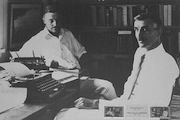NORDHOFF, CHARLES [BERNARD] the younger (1887-1947) AND JAMES NORMAN HALL (1887-1951). Writers Charles Nordhoff and James Norman Hall were born the same year but worlds apart, Nordhoff in London of American parents and Hall in Colfax, Iowa. They met during World War I as members of the Lafayette Flying Corps, whose history they subsequently detailed in written collaboration.
For their next project the two chose to produce a collection of travel pieces about the South Pacific, and they embarked for Tahiti early in 1920. Nordhoff went on to the Cook Islands, and Hall to the Tuamotu Archipelago; their account of their travels, Faery Lands of the South Seas, appeared the following year (1921). Both men continued living on Tahiti but at first pursued separate writing careers. By 1912 [1922? website ed.], however, the two had resumed collaboration, first on a juvenile novel about the Lafayette Flying Corps and then on a trilogy of novels about what they would help to make one of the most famous events in maritime history.
Inspired by a historical account of the mutiny aboard the H.M.S. Bounty on 27 April 1789, Nordhoff and Hall undertook to re-create the mutiny in fictional terms. If their first volume succeeded, they intended to treat subsequent events in further novels, and succeed it did. Mutiny on the Bounty (1932) was a best-seller and inspired a memorable motion picture in 1935, starring Charles Laughton as Captain William Bligh and Clark Gable as First Mate Fletcher Christian, the mutineers’ leader. Other film versions were released in 1962 and 1984, the latter with Mel Gibson and Anthony Hopkins.
Nordhoff and Hall followed Mutiny on the Bounty with Men against the Sea and Pitcairn’s Island (both 1934). The former elevates Bligh, the ostensible villain of the first volume, into a heroic figure who guides his tiny boat of loyalists for well over 3,000 miles across the Pacific to the island of Timor in the East Indies. The latter dramatizes the violent fate of the Bounty mutineers on Pitcairn Island, southeast of the Tuamotus, and is the least historical of the trilogy due to the paucity of information available. Although occasionally marred by problems of tone and, in the final volume, structure, the Bounty trilogy is popular fiction of a very high order. As testament to the enduring interest of the saga, William Kinsolving came out with Mister Christian in 1996, a fictional tale in which Fletcher Christian escapes Pitcairn Island, frees an Englishwoman from debauched privateers and finds love with her on a deserted island, finds his way to England, and survives as a fugitive between decks in the sea battles of the Napoleonic Wars.
Nordhoff and Hall continued to write, both independently and in collaboration, Hall four times more prolific than Nordhoff, but nothing they produced subsequently could match the dramatic appeal of their most famous saga. Hall produced a pendant volume in The Tale of a Shipwreck (1934), in which he discusses not only the Bounty but also a voyage to Pitcairn and the wreck of his own schooner on the return trip. Hall’s rollicking yarn Doctor Dogbody’s Leg (1940) was reprinted as a Heart of Oak Classic by Henry Holt in 1998. Together the two wrote The Hurricane (1936), The Dark River (1938), and No More Gas (1940), all minor works with a Pacific island setting; Botany Bay (1941), a grim, but far more substantial, novel about the infamous Australian penal colony; and Men without Country (1942), a slight adventure novel about prisoners who escape the penal colonies of French Guiana and sail across the Atlantic to offer their services to the Free French. In Lost Island (1944) Hall bade fictional farewell to the idyllic Pacific world he saw vanishing and in The Far Lands (1950) to the Pacific of the distant past.
Nordhoff died in California in 1947. Hall died in 1951, leaving an unfinished autobiography, My Island Home (1952). Hall’s grave in Tahiti overlooks Matavai Bay, where the Bounty once anchored.
Faery Lands of the South Seas (1921)
Archive.org
Google Books
HathiTrust
Mutiny on the Bounty (1932)
Men against the Sea (1934)
Pitcairn’s Island (1934)
Doctor Dogbody’s Leg (1940)
The Hurricane (1936)
The Dark River (1938)
No More Gas (1940)
Lost Island (1944)
My Island Home (1952)
keywords: male, white, co-authors, colonialism, shipwreck, movie

